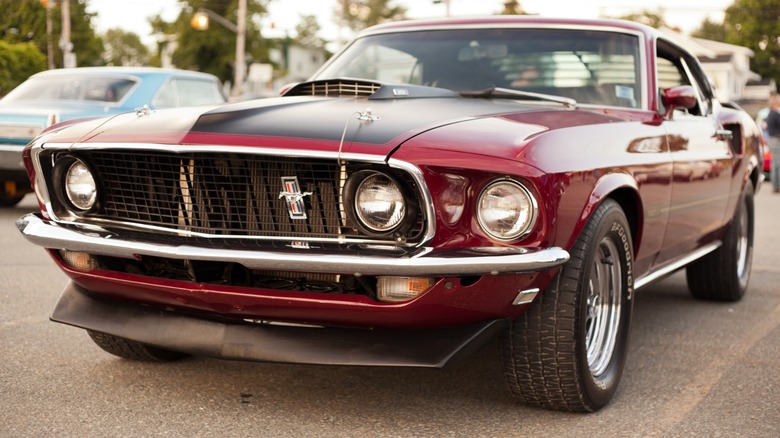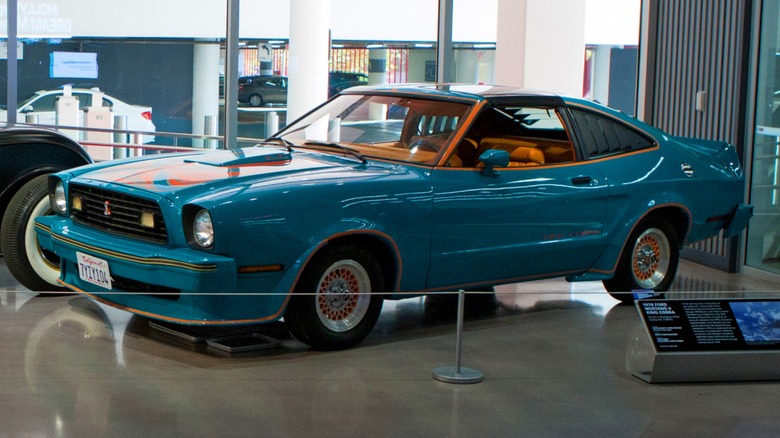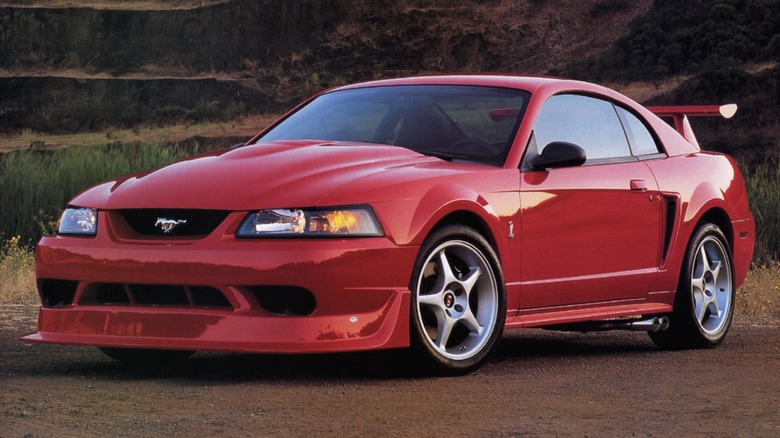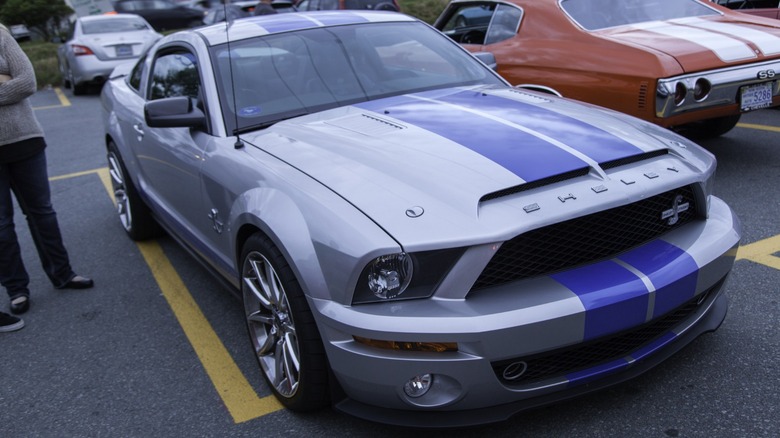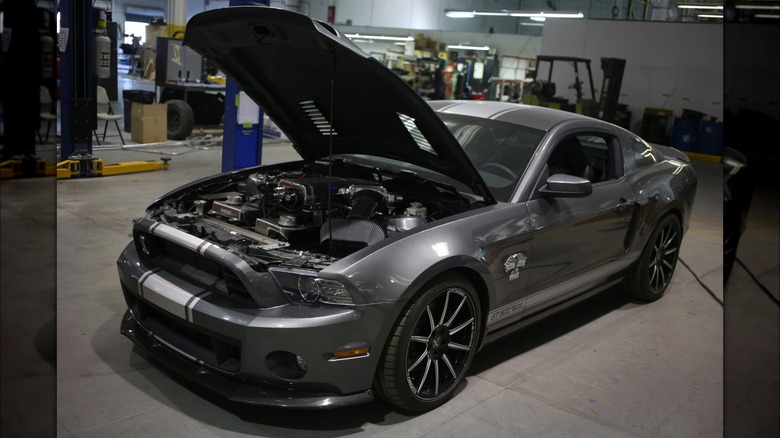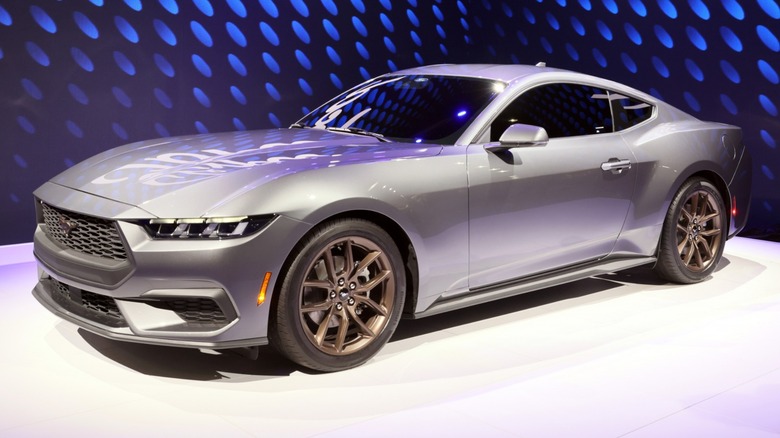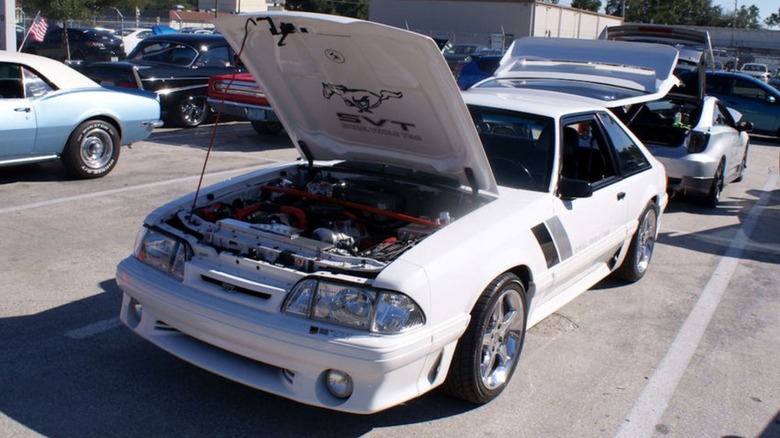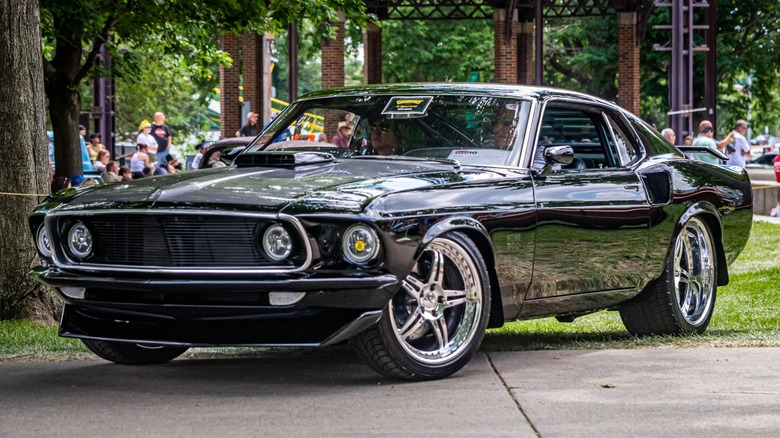The Most Powerful Mustang From Each Generation, Ranked
The Ford Mustang has been with us for more than half a century now. After establishing a whole new segment in the auto industry — the pony car — it has given us a plethora of beautiful slabs of steel and rubber to drive. With updates every seven to 10 years or so, new generations allow the Mustang to reinvent itself with new shapes and new technology to new detractors and fans alike. The first generation, which debuted mid-cycle as a 1964 1/2 model, was the brainchild of the legendary automotive executive Lee Iacocca, who was seeking a fresh, new, and sporty look in a car to rejuvenate Ford's prospects. The results were phenomenal.
Every generation of Mustang has been known for sporty handling and powerful V8 engines good for fast driving, even if some are better loved than others. Even though Mustangs have always been fast and powerful, some particular models rise above and outperform the rest. These are usually special editions available as pricey options packages that cause them to later become valuable and sought-after automotive gems. With that in mind, we're looking through the entire catalog of Ford's seven generations of factory-built Mustangs and highlighting the most powerful models from each one.
7. Second generation — 1978 King Cobra
Of the many things the second generation Mustang is known for, powerful engines and fast speeds are not top among them. Introduced on the heels of the highly successful and powerful Mustangs built at the height of the muscle car era, including legends such as the Shelby GT500, Boss 302, and Mach 1, the new model was a huge disappointment to most fans. In its initial year, only a 2.3-liter 4-cylinder or a 2.8-liter V6 was offered, topping the horsepower range at a paltry 105. Only in 1975 did it get a V8 option, but it was still underpowered at just 140 horsepower.
Ford attempted to bring things around with the King Cobra in its final year in 1978. This option, of which less than 5,000 were made, provided buyers with body enhancements including a rear spoiler, front air dam, and T-tops along with special decals and stripes. The hood was emblazoned with a stylized cobra graphic and the cars came in bold colors. Sadly, the engine offered little in the way of performance to match the exterior upgrades. Horsepower remained at just 139, which resulted in a 0 to 60 mph time of 9.8 seconds — an eternity in sports car time.
Through modern nostalgia-tinted lenses, these are nice-looking cars with loads of personality that are perfect for classic car lovers not concerned with performance at all. Still, through a contemporary lens, it was a sad representation of what the Mustang had become in just four short years. Being the fastest of the slowest Mustangs ever made is nothing to brag about.
6. Fourth generation — 2003-2004 Mustang SVT Cobra
The fourth generation Mustang had nearly become a front-wheel-drive car developed in conjunction with Mazda, even making it to the prototype phase. However, rumors, even in the pre-viral video era, began to circulate to the point that intense customer backlash forced Ford to reconsider and shelve the idea in favor of a traditional Mustang, while the prototype became the Mazda-powered Ford Probe. This left Ford with a need to replace the extremely popular Fox body with a new rear-drive car, which arrived in 1994.
The new 'Stang came with more curves and a generally sculpted look that was popular in the '80s, only for a mid-cycle refresh to incorporate some better-defined creases along the fenders and front end. This one debuted in 1994, continuing in production until 2004, which is also when the most powerful version of the car was released.
Ford's Special Vehicle Teams was assembled to create special high-performance versions of select cars in 1991. The Mustang was an obvious choice as one of its projects and the division created several models, including the 2003-2004 Mustang SVT Cobra. For this car, SVT injected a serious amount of power by adding a camshaft to each side of the Modular OHC engine and injecting a blast of air into it thanks to a supercharger. The result was 390 horsepower in a good-looking package affectionately dubbed the Terminator. With a quarter-mile time under 13 seconds and a top speed limited to 153 mph, this one has serious street cred.
5. Fifth generation — 2014 Shelby GT500
For the redesign of the Mustang planned for release in 2005, Ford looked to its archives for some fresh ideas. With a full retro styling phenomenon en vogue at the time, the new Mustang came with familiar styling features from front to rear. The headlights and front bumper took cues from the 1969 Mustang, including the optional fog lights inset into the grille, while its taillights returned with the triple vertical bars incorporating sequential turn signals. However, unlike some other retro flops, the Mustang took off running and stuck around for years longer than its inspiration.
In addition to bringing back some styling of past generations, Ford also brought back familiar names — Carroll Shelby and GT500. This resulted in the all-new Mustang Shelby GT500 with loads of new power. This time around, the GT500 came with a new Coyote engine that had been punched out to 5.8 liters and supercharged. Those who received the Shelby not only got the benefits of a full factory-backed warranty but also a screaming pony with 662 horsepower. The fifth-gen Mustang also went through a mid-cycle refresh, which had softened some of its retro characteristics but retained the handsome lines and overall aesthetic that made it popular in the first place.
4. Sixth generation — 2023 Mustang Shelby Super Snake
By the time Ford planners got to updating the Mustang for its sixth generation, retro styling had run its course and a more modern aesthetic was due to return. As such, the new car tossed the old-school look and came back with a new appearance that held true to the fundamentals of what made the Mustang so successful.
The 2015 Mustang celebrated 50 years of production and ushered in a new era in which base models offered 4-cylinder engines of the same size as the Mustang II in 1974 — a 2.3-liter — but with turbochargers added to more than triple the 88 horsepower to a healthy 310.
The Coyote 5.0-liter V8 continued to power the GT model with an abundance of power, and Shelby built upon this foundation with its Super Snake, upping the output to an incredible 825 horsepower. Taking the already powerful Mustang GT with its 480 horsepower Coyote V8, Shelby added a supercharger among other performance upgrades to create the most powerful Mustang ever available with a factory warranty. Unsurprisingly, none of this came for free as the Super Snake went on sale with a price tag approaching $140,000.
3. Seventh generation — 2024 Mustang Dark Horse
2024 marks the arrival of the seventh generation of Ford's Mustang, which also happens to be the only car left in Ford's lineup in North America. The latest iteration of the pony car comes without making drastic overhauls to the car but modernizes the design and continues its evolution consistent with current styling trends. While the aesthetic changes remain gradual, the technology changes have taken forward leaps, making the newest Mustang the most technologically advanced model yet.
The new Mustang features sharp styling with crisp and clear lines cut throughout. The front fascia provides an aggressive face for a car with equally aggressive mechanical prowess. The V6 has been dropped from the engine options, leaving the EcoBoost 4-cylinder and Coyote 5.0L V8 as the only engine choices. However, the minimum output is still more than 300 horsepower, and Ford has introduced its new Mustang Dark Horse for horsepower junkies. The Dark Horse comes only in dark shades or a matte black finish. Custom graphics and dark interiors complete the package while the Coyote 5.0 V8 pushes 500 horsepower through a 6-speed manual transmission.
While Shelby has offered the most powerful examples of Mustangs over the last few years, the next Shelby-built pony car likely won't come until the 2026 model year, leaving the Dark Horse as the top performer for now. However, that is not necessarily bad news as the Dark Horse should pack plenty of punch for all but a few drivers out there.
2. Third generation — 1993 Mustang SVT Cobra
Ford began experimenting with high-output cars in the '80s with its Special Vehicle Operations division, which is where the 2.3-liter Mustang SVO came from. That was an excellent runner that managed a peak output of 200 horsepower, which put it in league with the 230 horsepower of the contemporary Corvette. However, this would not be the pinnacle of power output for the beloved Fox body Mustang produced from 1979 to 1993.
The disappointment of the Mustang II was rectified when Ford released the Fox body. The redesigned pony car re-established the Mustang as a worthy sports car with good handling in a compact package at an affordable price. Initially, power was lacking but grew consistently throughout the period. Furthermore, the SVO unit was eventually replaced with SVT, which worked on several special edition cars for Ford for more than a decade. This included the 1993 Cobra, reintroducing a name that had been out of use since 1978.
However, the horsepower of the '93 Cobra only reached 235. While it was an improvement over the Mustang GT, which hovered below 200 horsepower at the time, it pales in comparison to the Mustangs of today. Nonetheless, it was a big step toward the rejuvenation of Mustang as a serious competitor on the street. Furthermore, the Fox body continues to be a celebrated sports car platform with a wealth of fans and aftermarket support to keep them driving for years to come, making the 1993 Cobra among the best of all Mustang generations.
[Featured image by Valder137 via Wikimedia Commons | Cropped and scaled | CC BY 2.0]
1. First generation —1969 Mustang Mach I 428 Cobra Jet
The old adage that there is no replacement for displacement rang true back in 1969 when Ford created the 428 Cobra Jet engine and made it available to Mustang buyers. Not yet encumbered by emission regulations and a nationwide fuel shortage, engineers were free to design and build engines as large as they wanted to focus on making as much power as the era's technology would allow.
Soon, the Mach I package debuted later in 1969 with the option of being ordered with one of a few V8 engines, the largest of which was the 428 Cobra Jet. In this guise, the Mach I was good for 335 horsepower, though that very well could have been underrated. Regardless, the giant engine gave you gobs of torque, ensuring that most other drivers' last memory of this car would be the cloud of smoke left behind as it shot ahead of almost anything else on the street.
You may have noted that Ford did create a Mustang in 1969 with a larger engine, the Boss 429, which was built specifically with intentions for NASCAR racing. While it did have a larger engine by one cubic inch and was created for the track, Motor Trend put them up against each other back in 2007 and found the Mach I to be the one to come out on top, even if only by fractions of a second. Furthermore, the Boss was a highly limited edition car now worth a fortune, while the Mach I is merely extremely expensive today.
